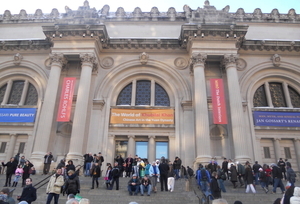The buildings grew taller and the traffic got heavier. The streets grew narrower and the honking got louder.
The skyscrapers were blanketed in an uncharacteristically heavy snowfall, giving the city a softer look than usual.
On Dec. 29, New York City welcomed me on my adventure to visit the Metropolitan Museum of Art.
We decided to take a cab to the Metropolitan Museum of Art. We flagged down a cab with ease, but getting in was another story with the mountains of dirty snow that covered the edges of the sidewalk.
We broke through the barricades, slush seeping into our shoes, and climbed into the cab.
Walking around the streets of New York, dozens of different accents and a variety of languages can be heard. As if illustrating the diversity that New York City has to offer, our cab driver was from Kosovo. He spoke five different languages and was planning to leave the city soon and go to France for two years to learn the language. After that, he planned on going to Egypt to learn Arabic.
He hated being a cab driver and he hated living in New York City. “It is a nice place to visit but it is not a nice place to live. Don’t come here to live. If you lived here, you would not be smiling like you are now. The women here never smile,” he said.
While his disdain for the city might have to do with his frustrating, stressful job, he gave us some words of wisdom to take with us on our journey. “If you are always happy with what you have, then your soul will be free,” he said.
Arriving at the Met, we left the cab of wisdom and stood on Fifth Avenue facing the imposing columns that supported the beautiful stone building. The museum is almost a quarter mile long and is one of the largest art galleries in the world.
Some say that it could take weeks to see everything the Met has to offer, and we only had a few hours.
The fare is pay what you wish, meaning that they suggest a $20 donation, but will admit anyone for as little as a penny, although they might throw a haughty glare in your direction along with the receipt.
Our first stop was their annual Christmas tree. This tree was unlike any other, not adorned with twinkly lights or glass ornaments, but with Neapolitan-style nativity characters.
Next, we entered the spacious room that was home to the Greek and Roman galleries.
Natural light poured in through the many windows overlooking snow-covered Central Park, illuminating the pristine sculptures in an almost angelic way. Hellenistic Greeks portrayed perfection, strength, and youth in their art, from the rippling muscles of a young man to the perfect curls of a young woman. The flawless marble figures have no imperfections or blemishes, unlike how young people actually look.
The modern art exhibit was my next stop. Many people ridicule modern art, comparing some to a finger-paint drawing that a five-year-old created. However, I enjoy drawing my own conclusions from what I see in front of me. I like taking my own interpretation of it, knowing that no one else will see exactly what I saw.
The modern art exhibit displays an incredible variety, from Georgia O’Keefe’s luscious flowers to a blank white canvas with colorful streams of paint running from the top corners to the edges. Some canvases were arrays of shapes and bright colors, leaving the viewer to decipher their own version of what it might be. One piece of artwork was a collection of tiny people turned so that their feet were touching the wall. All the viewer had to do was turn their head to the side and they saw a whole new world.
Tearing myself away from the crazy world of modern art, we entered the Galleries for 19th and early 20th century European paintings and sculpture. This massive exhibit displayed art from 1800 to the early 20th century.
The portrait rooms in the Met resemble a corn maze without no man on stilts prepared to find you if you get lost. Once you enter one exhibit, you may never get out. A night at this museum became a real possibility.
Distracted by the beautiful displays, I roamed around, pausing at paintings that caught my attention. One of my favorites was Pierre Bonnard, a French artist who went against the Impressionism of his time and joined fellow artists in creating the Nabis, also called Symbolists or the prophets. They painted from memory or imagination, using vibrant colors to create something that is not simply a recreation of reality.
The confusing labyrinth of art never seems to end as the spacious rooms kept on splitting off into more rooms. One room would be full of Monet’s signature landscapes, and the next would be full of Van Gogh’s swirling colors. The Met is like a wardrobe that opens up to a Narnia of art, and I never wanted to go back to the real world.
However, our time in the city was limited and we emerged from the museum almost four hours later than we had entered it. We ate lunch on the steps and said good-bye to the Met.
As I turned around for one last glimpse, my feet lost in a pile of snow, I knew as surely as the slush in my boots that I would be back.



